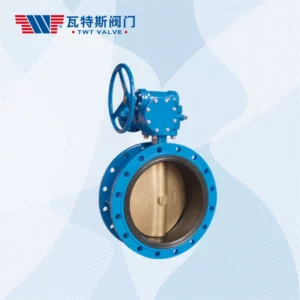Large size double flange butterfly valves are used in various industrial applications and are typically constructed using materials suitable for handling high pressures, varying temperatures, and different types of fluids.
The materials commonly used for manufacturing the disc in these valves include:
- Stainless Steel: Stainless steel discs are often used due to their corrosion resistance and strength. Variants like 316 stainless steel offer excellent resistance to corrosion in various environments and are suitable for handling corrosive fluids.
- Carbon Steel: Carbon steel discs are robust and durable, making them suitable for applications where strength and reliability are paramount. They can handle high-pressure situations and are often used in industrial settings.
- Alloy Steel: Alloy steel discs, which contain additional elements beyond carbon and iron, are chosen for their enhanced properties, including better resistance to corrosion, high temperatures, and wear. They are commonly used in demanding applications where extreme conditions are present.
- Ductile Iron: Ductile iron discs provide good mechanical properties, offering strength, impact resistance, and durability. They are often used in applications requiring a balance between strength and cost-effectiveness.
- Nickel-Aluminum-Bronze (NAB): NAB discs are suitable for corrosive environments, seawater applications, or where resistance to erosion, corrosion, and cavitation is crucial. They offer excellent resistance to saltwater corrosion and are used in marine and offshore industries.
- Hastelloy® or Inconel®: These high-performance alloys are used in highly corrosive environments, extreme temperatures, or in handling aggressive chemicals. They provide exceptional resistance to corrosion, oxidation, and high temperatures.
The choice of disc material for large size double flange butterfly valves depends on factors such as the type of fluid being handled, operating temperatures and pressures, corrosiveness of the environment, and specific application requirements. large size double flange butterfly valve Manufacturers often offer different disc material options to suit various needs and ensure optimal performance and longevity of the valve in diverse industrial settings.
How does the large size double flange butterfly valve’s affect the flow of fluids?
Large size double flange butterfly valves play a significant role in controlling the flow of fluids within industrial pipelines.
Their design and characteristics impact fluid flow in several ways:
- Flow Control: These valves modulate flow by altering the position of the disc within the pipe. Rotating the disc allows for varying degrees of obstruction or opening, regulating the flow rate through the pipeline.
- Pressure Drop: Large size double flange butterfly valves are engineered to minimize pressure drop across the valve when fully open, allowing fluids to pass through with minimal resistance. This characteristic is crucial to maintain system efficiency and reduce energy losses.
- Turbulence and Flow Characteristics: Properly designed valves can minimize turbulence and maintain a laminar flow profile, especially when partially open. This is crucial in applications requiring smooth and controlled flow, reducing the risk of vibration or noise generation within the pipeline.
- Shut-Off Capability: When fully closed, these valves provide tight shut-off, preventing the passage of fluids through the pipeline. This capability ensures complete isolation when needed for maintenance or emergency situations.
- Flow Containment: Double flange butterfly valves are capable of containing and controlling the flow of a wide range of fluids, including liquids, gases, and slurries, making them versatile in various industrial applications.
- Versatility in Flow Regulation: They offer precise flow regulation across a range of flow rates, allowing for accurate control in diverse industrial processes.
- Resilience to Cavitation and Water Hammer: Properly designed large size butterfly valves can mitigate cavitation effects and water hammer phenomena, which can occur due to rapid changes in flow rates or pressure, thereby preventing potential damage to the valve and the piping system.
- Scalability: Their design allows for scalability to larger sizes without significant impact on performance, making them suitable for various pipe diameters and flow capacities.
Overall, the design and operation of large size double flange butterfly valves significantly influence the flow of fluids within pipelines, providing precise control, efficient flow regulation, and reliable shut-off capabilities in industrial settings. The valve’s proper selection and installation are critical to ensure optimal performance and compatibility with specific application requirements.
